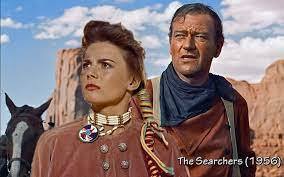A Vulnerable Character
We were talking in last week’s post about A Man at Arms falling into the “Western” genre, even though the book is set in the ancient world—much as many samurai movies are Westerns, as well as post-apocalyptic tales (Mad Max, The Book of Eli), mutant tales, and even, in my opinion, John Wick movies.
Okay. How does that help us? If we’re assembling elements of a nascent story, trying to make them come together into a coherent narrative with three acts and a theme and a crisis/climax/resolution, how does it help us to identify our material as belonging to a particular genre, in this case a Western?
 Natalie Wood and John Wayne in “The Searchers:”
Natalie Wood and John Wayne in “The Searchers:”Here’s one thing: we know that the moral narrative of most Westerns hinges upon a Vulnerable Character.
Not the hero.
Not the villain.
But a third character (or characters) whom the villain is oppressing and whom the hero will, in one form or another, come to defend.
In Shane, this “character” is the homesteaders, particularlzed by the Starretts—Joe, Marian, and Joey.
In Seven Samurai, it’s the villagers. In The Searchers, it’s Debbie (Natalie Wood), kidnapped by the Comanche war chief, Scar. In Unforgiven, it’s the prostitutes of Big Whiskey, Wyoming.
In Casablanca, the Vulnerable Character is Ilsa Lund (Ingrid Bergman). I would, in fact, classify Casablanca as a Western.
I think of this Vulnerable Character much like “the Rival,” which Shawn tells us is an absolute necessity in the Love Story genre. It’s possible as a writer to literally sit down and ask ourselves, “Who is our ‘Rival?’” Or “Who is our ‘Vulnerable Character’?” And if we don’t have one, to make one up from scratch—just because we know we have to have one. It’s a convention of the genre.
In A Man at Arms, I didn’t do it that way. The character popped into my head just on instinct.
A nine-year-old girl. Mute. Ragged. Feral. Someone easily dismissed as less than human, a freak. Instinct told me that this character should be pursued by the Bad Guys—the Romans. They must want her for some reason, even though I didn’t know yet why.
I’m still not sure why having a young, mute girl as the Vulnerable Character appealed to me so much. Maybe because I sensed that, as the story evolved, this character would show herself to be anything but what she first seemed to be. And that in the end she would prove to be the supreme warrior in the drama.
But what really counted was this character’s relationship to our hero, to the solitary mercenary Telamon of Arcadia. She would have to be the agent of his transformation—as the Starretts and the Japanese villagers and Debbie and the prostitutes of Big Whiskey turn out to be for the protagonists of their stories. Somehow, I told myself, Telamon must become emotionally involved with her. He must come to care for her and be called to defend her.
Can you see how this material is starting to come together, even at this early stage–when we don’t have an actual story?
But we’ve got the working parts. We’ve got a hero, a villain, a McGuffin, a geographical and psychological “world of the story” (the Sinai desert, where the chase will take place), and we’ve got a Vulnerable Character around whom our hero’s Big Change will revolve.
The post A Vulnerable Character first appeared on Steven Pressfield.


